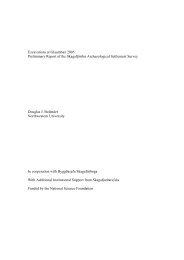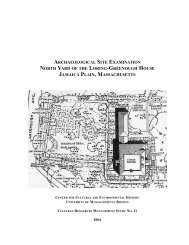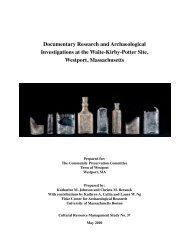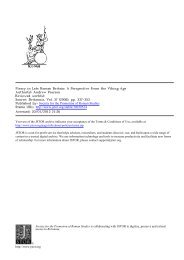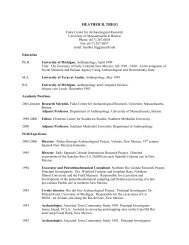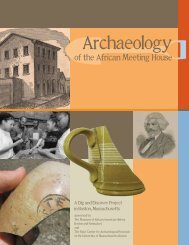Barrett, Locker and Roberts - Fiske Center
Barrett, Locker and Roberts - Fiske Center
Barrett, Locker and Roberts - Fiske Center
You also want an ePaper? Increase the reach of your titles
YUMPU automatically turns print PDFs into web optimized ePapers that Google loves.
James H. <strong>Barrett</strong>, Alisou M. <strong>Locker</strong> & Callum M. Roherts<br />
were excluded from consideration if they were not recovered at least in part by sieving, could<br />
not be attributed to one of five two-century periods or did not yield at least 50 identified<br />
specimens. A few assemblages bave also been excluded because they represent unique<br />
circumstances - such as shipwrecks (Hamilton-Dyer 1995) <strong>and</strong> fish gut contents (Irving u<br />
1998). The corpus is dominated by urban <strong>and</strong> 'proto-urban' sites, but effort has been made ^<br />
to include as many rural settlements as practicable without introducing poor-quality S<br />
information (from unsievcd assemblages, for example).<br />
Fhe sample size threshold is set low (cf Amorosi et al. 1996:155) given the small number of<br />
fish bones from most pre-cleventh century (particularly rural) settlements. The sieving<br />
requirement is necessary given the impact of poor recovery on species representation (Jones<br />
1982; Vale & Gargett 2002). Although it was not always possible to distinguish the sieved <strong>and</strong><br />
unsievcd portions of mixed assemblages, the degree to which sieving was practiced (partially or<br />
totally) does not show chronological patterning (Chi-Square - 5.62, df ^ 4, p ^ 0.230) <strong>and</strong> is<br />
tbus tinlikely to bias the overall results. Where known, the minimum mesh size used does vary<br />
by period (Kruskal-Wallis C!!bi-Square = 19.42, df = 4, p = 0.001), but the tise of finer sieves is<br />
associated with eleventh century <strong>and</strong> later assemblages. Thus it is unlikely to be responsible for<br />
tbe patterns identified, in which large cod <strong>and</strong> related species became more common at the<br />
expense of smaller taxa such as eel <strong>and</strong> cyprinids (see below). It could, however, have a minor<br />
impact on the relative abundance of herring. Data are not available to compare preservation<br />
differences between samples (cf. <strong>Barrett</strong> 1997), but it is reasonable to assume that the species<br />
under consideration were not differentially preserved in different periods.<br />
The 'fish event horizon'<br />
Over the millennium under consideration, eight taxonomic groups dominate English fish<br />
assemblages. The marine taxa are herring <strong>and</strong> cod-like fishes ('gadids' - for present purposes<br />
this grotip is treated as including the related hake, Merluccius merluccius, <strong>and</strong> excluding the<br />
freshwater btirbot. Lota lota). The freshwater taxa are fishes of the carp family (cyprinids)<br />
<strong>and</strong> pike {Hsox Itidus). The migratory taxa are European eel {Anguiila anguiila), salmon <strong>and</strong><br />
trout (salmonids), smelr [Osmerus eperlanus) <strong>and</strong> fiatfish (a group which includes flounder,<br />
Platichthys flesus, tbat enters fresh water, but also marine species). When these groups are<br />
compared using Correspondence Analysis (CA) (Baxter 2003:136-145), it is clear that virtually<br />
all Vatches' from the seventh to the tenth centuries were dominated by freshwater <strong>and</strong><br />
migratory species (particularly cyprinids <strong>and</strong> eels) (Figure 2a). Conversely, most eleventh<br />
century <strong>and</strong> later 'catches' had far more herring <strong>and</strong>/or gadids. Flatfish are predictably<br />
intermediate between theNse groups, given their mix of freshwater <strong>and</strong> marine species. In the<br />
thirteenth to sixteenth cenrtiries some assemblages were dominated by gadids alone. Fhere is<br />
no distinctive pattern associated with the fifteenth to sixteenth centuries, when the English<br />
cod fishery exp<strong>and</strong>ed first to Icel<strong>and</strong> <strong>and</strong> later to Newfotindl<strong>and</strong> (Jones 2000). This implies<br />
that changes in fishing in the eleventh to twelfth centuries were more dramatic than better<br />
known later developments.<br />
There are few exceptions to these general patterns. One thirteenth to fourteenth century<br />
case (Grant 1988) <strong>and</strong> one fifteenth to sixteenth centtiry assemblage (Wheeler 1979) resemble<br />
pre-eleventh centtiry examples because they are specialised collections consisting almost entirely<br />
ol eel. Other outliers are related to site location. Fbc few early assemblages with relatively<br />
62}



